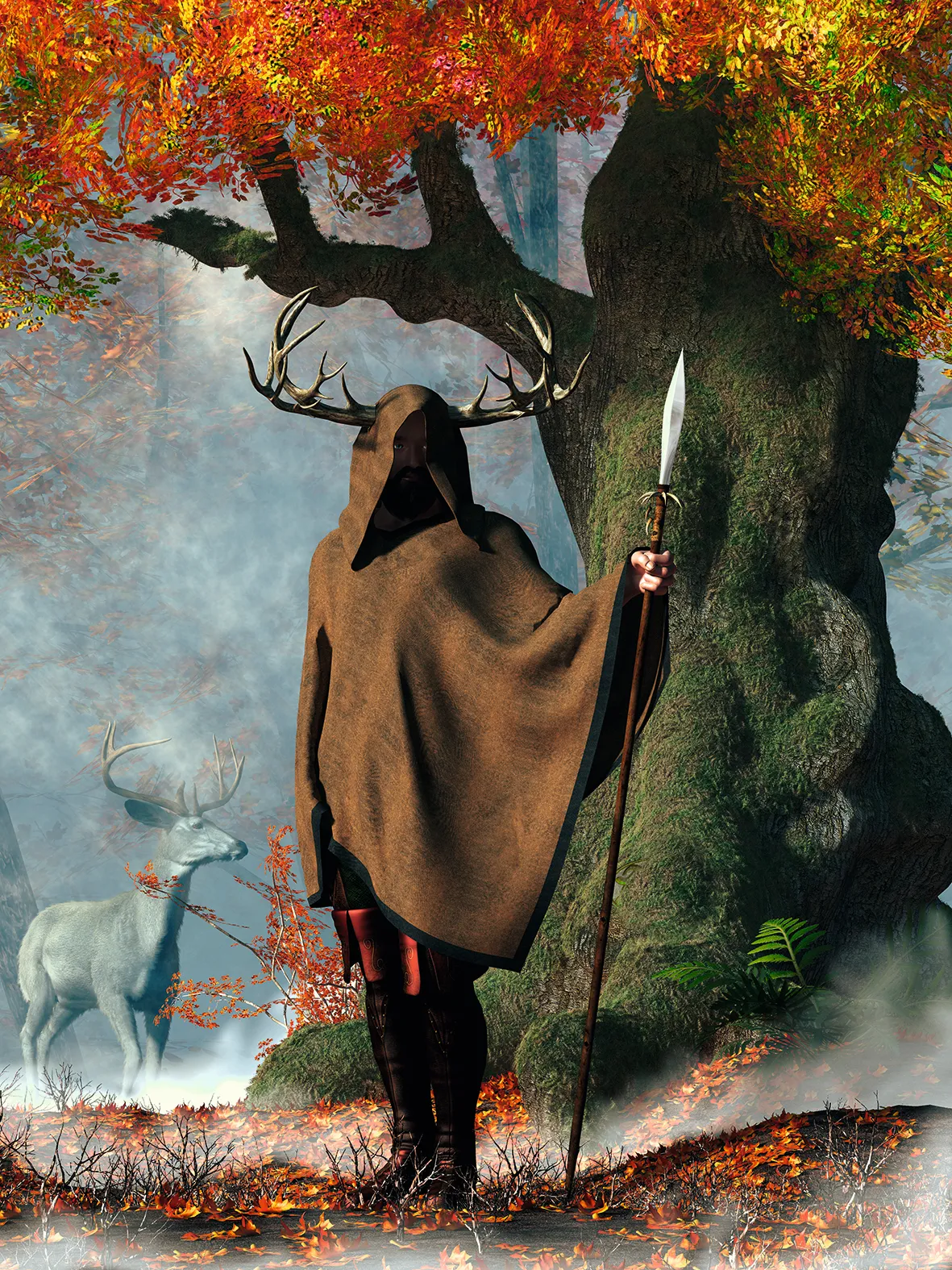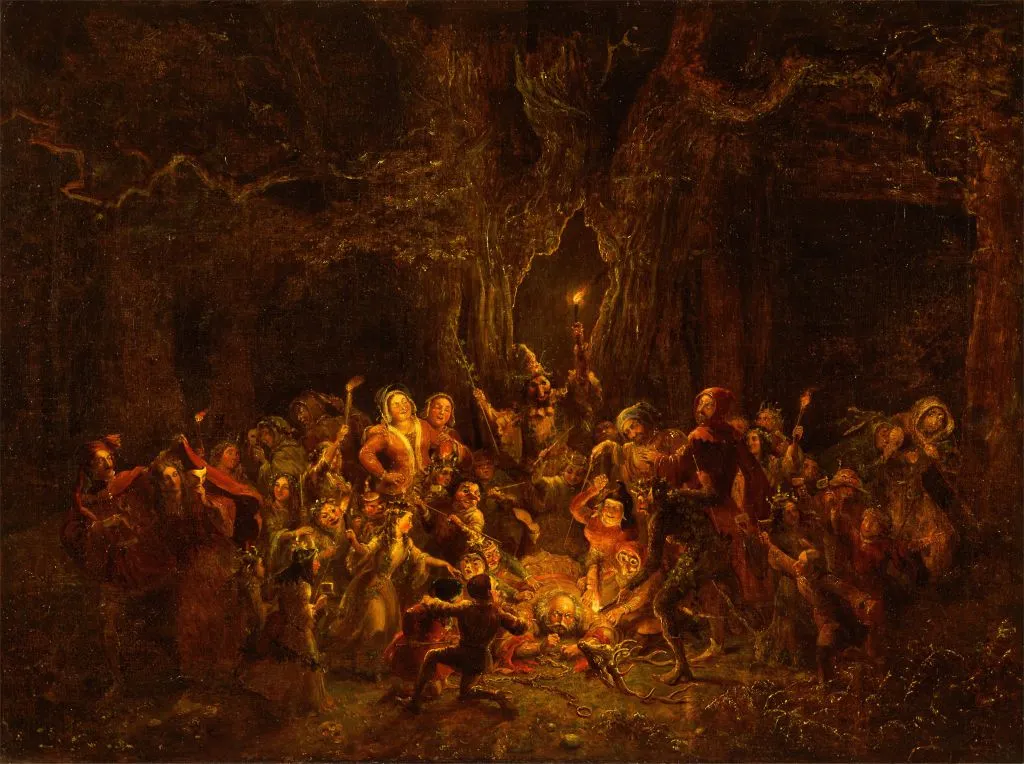It’s late dusk, and you’re lost. Shapes are moving in the mist ahead, holding your gaze. A hunting horn echoes through the trees; there’s the jangle of a harness, the baying of hounds, the thud of hooves on turf. A terrible figure, with antlers emerging from his forehead, is leading the ghostly group across your path. He knows exactly where he’s going. Meet Herne the Hunter.
The ancient oak and beech trees at Windsor Great Park, on the Berkshire/Surrey border, have witnessed many human lives come and go: William the Conqueror, who decreed strict forest laws next to his new castle almost 1,000 years ago; Henry VIII and James I, who prized the deer for good hunting in the 16th and 17th centuries, and of course countless commoners, who have always travelled here as their birthright, permitted or not.
Today, the park is part of the Crown Estate, protected for its ancient trees and the invertebrates living in them. Although it’s important for nature, this place is far from wild. Yet under the grass and behind the venerable old trees there are traces of a wild folk hero.
- Where is the most haunted place in Britain?
- Spectacular royal palaces, castles and houses to visit
- Where Britain's lost kings are buried
What is the myth of Herne the Hunter?
Richard Herne – so the story goes – was master of the hunt at Windsor in some bygone age; it is not clear exactly when. Many at court were jealous of his skills and his influence with the King. When Herne saved the King from being gored by a stag, the King heaped gifts on him: a gold chain, a silver hunting horn, some say the antlers of the offending stag.
The jealousy of those around Herne grew stronger. They betrayed Herne with false evidence that he had taken the King’s deer and broken forest law. Banished from the court, Herne took his own life. He was found hanging from a great oak in Windsor forest.
After Herne’s burial, his enemies found they were weakening day by day. Two of them visited the grave and found themselves pursued by Herne’s ghost, with tall antlers and a silver hunting horn at his lips.
Some say those two black-hearted courtiers were discovered hanging from the same oak tree the following morning, their faces contorted in terror. Others that the pair were forced to join Herne’s ghostly ‘wild hunt’ (of which more below), and that they still ride out today to protect the forest and do penance for their wrongs. Woe betide any wrongdoers who cross the wild hunt’s path, for they may suffer the same fate.
Herne, the Royal Family's ghostly guardian
And perhaps Herne hasn't retired from safeguarding the British Royal Family. For Herne and the wild hunt are still said to appear at times of foreboding and to warn of the death of the monarch. Their presence was reported by witnesses during both world wars, and on the death of King George VI in 1952; who knows whether his daughter the late Queen Elizabeth II saw him as well.
Where did Herne the Hunter originate from?

Herne the Hunter’s story has been reimagined so often that it is difficult to tell which parts derive from folklore and which from the fertile imaginations of poets and authors. This is the very essence of how stories develop; looking back, we can try to trace Herne’s path through the woods of medieval England.
The first written mention of Herne dates from 1597. In The Merry Wives of Windsor, William Shakespeare’s Herne the Hunter is the ghost of a keeper in Windsor Forest who blasts an oak tree with his anger, wears “ragg’d horns” and turns cow’s milk to blood. Shakespeare sought to ridicule these folk beliefs, but he gives us evidence that the tale of Herne was old even then.

By the early 19th century, the romantic notion of the wild hunt had been taken up with glee by poets and authors. WH Ainsworth’s 1843 novel Windsor Castle features Herne the Hunter as an enchanted keeper in Richard II’s court who was wronged by his colleagues, and whose ghost came back to claim their lives for his hunting party.
Almost a century later, Herne appeared in poet laureate John Masefield’s magical novel Box of Delights in 1935. Little more was written about him until the 1960s and 1970s, when he appeared in fantasy novels such as Susan Cooper’s The Dark is Rising sequence and Alan Garner’s The Moon of Gomrath. A shamanic version of Herne was transported north in 1984 and introduced to television in Richard Carpenter’s Robin of Sherwood. The figure of Herne now looms everywhere in our popular culture, in music, film, literature and games.
So what unites these many versions of Herne? He is part-man, part-beast; he is all about nature. Modern pagans – followers of new religious movements based on nature and the folklore of pre-Christian peoples – have embraced Herne, too, transforming him into a fierce, wild nature god.
Perhaps it’s no wonder that Herne is popular today. In our modern lives, disconnected from the arduous task of taming nature for our daily needs, many of us long for wildness and a rewilded land. Such longings are at odds with the structures of modern society that have accumulated over millennia, and they can be frustrating and difficult to define. Herne provides us with a folklore muse on our relationship with nature, and our notions of ‘wild’ and ‘tamed’.
There’s inspiration here. With a wry comment in his Discworld series, Terry Pratchett parodies Herne as ‘Herne the Hunted’: the god of small animals who suffer undignified deaths. In 2020’s The Book of Trespass, Nick Hayes reimagines Herne’s followers as those on the edge of society fighting for land rights.
Discover other ghostly protectors
In his attempts to warn the nation of danger, Herne’s ancient lineage is a noble one. The head of the great warrior Bran the Blessed is said to lie buried at Tower Hill in London, protecting the country together with his namesake ravens (‘Bran’ is Welsh for ‘crow’). King Arthur and his warriors sleep under Craig y Ddinas in Wales, only to be woken in our greatest time of need.
In Shropshire, Saxon lord Wild Edric and his followers will ride out when England goes to war.
Recent literature has responded to dangerous times with similar themes. Tolkien wrote The Lord of the Rings during the Second World War and its aftermath; Aragorn the ranger waits patiently to become king and heal the land. The Ents, tree-spirits slow to rouse but terrifying when angry, are the war-cry of nature itself. Yet there is a price to be paid after war: a sad diminishing of magic in the land as the new era begins.
Whether they appear as ghosts or ideas, folklore’s otherworldly protectors can bring comfort in troubled times. The story of Herne reflects back to us our desire to believe in something other than the literal and physical; a wild spirit who will mete out justice, protect us and bring us back to nature and the land, when we are in danger of losing our way in the mist.
Top image: Herne the hunter appearing to King Henry VIII, pointing to distance castle, from hill clearing, illustration by George Cruikshank, from Ainsworth Magazine/Getty Images
